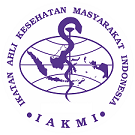Hazard Quotient Association of SO2 Exposure to Respiratory Symptoms: Study on Scavengers in Sarimukti Landfill, West Bandung Regency, East Java, Indonesia
DOI:
https://doi.org/10.26911/jepublichealth.2025.10.05.12Abstract
Background: The WHO reported that airborne diseases were responsible for 39 million deaths, accounting for 57% of the total 68 million deaths worldwide in 2021. Landfills are a significant source of air pollution, producing sulfur dioxide (SO2) gas, which is harmful to respiratory health, particularly the lungs. This study aims to examine the relationship between the hazard quotient of SO2 exposure and respiratory symptoms among scavengers at the Sarimukti landfill in West Bandung Regency, using an environmental health risk analysis approach.
Subjects and Method: The research contributes to exposure risk management by establishing safe thresholds for SO2 concentration, exposure time, and frequency for scavengers. This study adopts a correlation design with a longitudinal approach. The sample consisted of 101 scavengers selected through accidental sampling. Pollutant measurements were taken at two locations within the Sarimukti landfill. The independent variable in this study is the hazard quotient value of SO2 expo-sure, while the dependent variable is respiratory symptoms in scavengers.
Results: The results indicated a (OR= 15.83; 95% CI= 1.10 to 226.67; p= 0.008). Risk management is based on a safe SO2 concentration limit of 14.18 µg/m³, an exposure time of 15 hours, and an exposure frequency of 637 days over 30 years.
Conclusion: The measurement result of SO2 concentration of 7.38 µg/m³ is still below the specified quality standard of 150 µg/m³. However, through the calculation of the hazard quotient, the concentration exceeds the safe limit (HQ >= 1). The implication of this study in preventing the occurrence of respiratory symptoms in waste pickers is the use of PPE, limiting working hours and days in the landfill.
Keywords:
Air pollution, hazard quotient, respiratory symptoms, sulphur dioxideReferences
Anastasopolos AT, Sofowote UM, Hopke PK, Rouleau M, Shin T, Dheri A, Peng H, et al. (2021). Air quality in Canadian port cities after regulation of low-sulfur marine fuel in the North American Emissions Control Area. Sci Total Environ. 791:147949. doi: 10.1016/j.scitotenv.2021.147949.
Barros RM, Tiago FGL, Santos AHM, Ferreira CH, Pieroni MF, Moura JS, Abe HSDS, et al. (2018). A potential of the biogas generating and energy recovery from municipal solid waste. Renew Energy Focus. 25:4–16. doi: 10.1016/j.ref.2018.02.001.
Cao D, Zheng D, Qian Z, Shen H, Liu Y, Liu Q, Sun J, et al. (2022). Ambient sulfur dioxide and hospital expenditures and length of hospital stay for respiratory diseases: A multicity study in China. Ecotoxicol Environ Saf. 229:113082. doi: 10.1016/j.ecoenv.2021.113082.
D’Costa J, Keita DS, Braganza VJ, Patel H.+ (2024). Environmental Impact Assessment of the Solid Waste Landfill in Ahmedabad. J Inst Eng (India) Ser A. 105:589–601.doi:10.1007/s40030-024-00814-4.
Mercan Y, Babaoglu UT, Erturk A (2020). Short-term effect of particular matter and sulfur dioxide exposure on asthma and/or chronic obstructive pulmonary disease hospital admissions in Center of Anatolia. Environ Monit Assess. 192:646.doi:10.1007/s10661-020-08605-7.
Ndagiman AL, Suleiman DR, Sulaimon I (2024). Investigating the Energy Potential and Quantification of Bida Waste Landfill: A Case Study of Kutufani Dump Site. Arid Zone J Eng Technol Environ. 20:45–62.
Niu Z, Liu F, Yu H, Wu S, Xiang H (2021). Association between exposure to ambient air pollution and hospital admission, incidence, and mortality of stroke: An updated systematic review and meta-analysis of more than 23 million participants. Environ Health Prev Med. 26:15. doi: 10.1186/s12199-021-00937-1.
Nurhisanah S, Hasyim H (2022). Environmental health risk assessment of sulfur dioxide (SO2) at workers around in combined cycle power plant (CCPP). Heliyon. 8:e09388. doi: 10.1016/j.heliyon.2022.e09388.
Serbula SM, Milosavljevic JS, Kalinovic JV, Kalinovic TS, Radojevic AA, Trujic TLA, Tasic VM (2021). Arsenic and SO2 hotspot in South-Eastern Europe: An overview of the air quality after the implementation of the flash smelting technology for copper production. Sci Total Environ.777:145981.doi: 10.1016/j.scitotenv.2021.145981.
Shen S, Li X, Yuan C, Huang Q, Liu D, Ma S, Hui J, et al. (2020). Association of short-term exposure to sulfur dioxide and hospitalization for ischemic and hemorrhagic stroke in Guangzhou, China. BMC Public Health. 20:263. doi: 10.1186/s12889-020-8354-0.
Soltan-Abad RM, Kheirouri S, Abbasi MM, Alizadeh M, Khordadmehr M (2021). Effect of sulfur dioxide exposure on histopathology and morphometry of pancreatic islet cells and glycemic indices in Wistar rats. Environ Sci Pollut Res Int. 28:45739–45744. doi: 10.1007/s11356-021-12672-9.
Vaverková MD (2019). Landfill Impacts on the Environment—Review. Geosci. 9: 431. doi: 10.3390/geosciences9100431.
Wang L, Liu C, Meng X, Niu Y, Lin Z, Liu Y, Liu J, et al. (2018). Associations between short-term exposure to ambient sulfur dioxide and increased cause-specific mortality in 272 Chinese cities. Environ Int. 117:33–39. doi: 10.1016/j.envint.2018.04.019.
WHO. (2024). The top 10 causes of death World Health Organization. Retrieved December 8, 2024.
Wu Y, Li R, Cui L, Meng Y, Cheng H, Fu H (2020). The high-resolution estimation of sulfur dioxide (SO2) concentration, health effects and monetary costs in Beijing. Chemosphere. 241:125031. doi: 10.1016/j.chemosphere.2019.125031.
Yan H, Tong W, Wang J, Li P, Wang X, Zhang Y (2024). The recycling of sulfur in waste and conversion to manganese sulfate: Process optimization, kinetic study, mechanistic insights. Can J Chem Eng. 102:3424–3436. doi: 10.1002/cjce.25282.




1.jpg)








